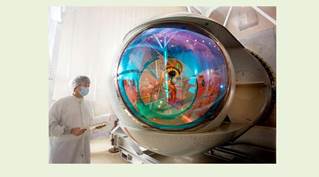application remains unclear.


There also exist another type of weapons. Anti-personnel laser weapons are inexpensive, sold openly by the Third World, have line-of-sight aiming, and are capable of producing catastrophic results if used against aircrews and sensors in flight (especially during takeoffs and landings). Commercially available laser weapons include the ZM-87, developed by the Chinese and first displayed at the International Defense Exhibition in 1995. In addition, the Russians sell a truck-mounted high-energy laser. And the University of Tasmania in Hobart sells a CO2 laser system for controlling forest undergrowth. The system is used to ignite logging debris from distances of 100 to 1,500 meters. The laser, costing $86,500, is mounted on a gun turret carried in a 2-ton truck and is simple to operate. Similar systems are available commercially throughout the world.

Data from the NASA Aviation Safety Reporting System database for the last two years provide examples of commercial flights in which the pilots suffered eye damage from lasers. These include aircraft landings at Honolulu, Las Vegas, Miami, New York, Los Angeles, and Phoenix. In Phoenix, one crew member was flashblinded, with resulting after-images and loss of night vision for about 10 hours. Takeoffs have also been affected: in a 737 outbound from Los Angeles, two pilots were struck by a blinding flash that lasted 5 to 10 seconds. The first officer had burns on the outer eye and broken blood vessels. In a flight from Cleveland, one crew member received a bright blue light in his right eye and experienced vision impairment for the next 10 hours. Data from the National Air Intelligence Center indicate that, in the U.S. alone, commercial lasers have caused over 50 blinding incidents.

http://www.fas.org

 Electronic Engineering 125
Electronic Engineering 125

 5. Future Challenges in Biomedical Engineering
5. Future Challenges in Biomedical Engineering

A man with a new prosthetic arm can ‘feel’ things and thereby grip eggs without breaking them. His prosthesis has a computer in the forearm that is wired to a mechanical hand and to a "plunger" device on his chest. The hand sends signals up the wires to the plunger, which pushes the skin. That stimulates nerves in his chest, which have been rewired there from where they used to be in the upper arm, to transmit sensations to the brain as if the nerves were still connected to his real hand.

This is just one example of the amazing progress that has been made in medical science over the last few decades. This progress has come hand in hand with technological advancements in electronic and mechanical engineering, computer science, and information and communication technologies (ICT). The blending of all these fields is biomedical engineering, the application of the principles of engineering to the solution of problems in biology and medicine.

Progress in biomedical engineering has never been more rapid and exciting than it is today. This progress is driven both by the identification of problems that need to be solved - "clinical pull" - or by the invention of new tools, the application of which may move medicine into new areas - "technology push". Present research indicates that the field will continue expanding and growing at high rates with numerous amazing contributions to public and individual health. Innovations will continue to revolutionize clinical practice whether by providing solutions to the challenges of obtaining fast and reliable diagnoses, providing less traumatic therapies, managing the ever increasing volumes of data, or discovering and developing radical new technologies which lead to completely novel procedures.

Specific advances could include storage of genetic profiles in a database accessible to doctors nationwide. People may live in smart houses equipped with sensors to monitor the status of their general health. Everyone may have access to regular non-invasive screenings to detect disease as early as possible. Efficient noninvasive sensor-based procedures may also monitor and evaluate cardiovascular and musculoskeletal system health.

A call to emergency services in the year 2050 will bring a new kind of ambulance to the door. The ambulance will be equipped to assess patient status more thoroughly using on-board blood analysis, scanners and computer diagnoses to facilitate proper and efficient patient handling during transport and upon arrival at the hospital. Once at the hospital, advanced scanners will make clear and realistic pictu-

res of the inside of the body, which will be supplemented by information from laboratory tests using automated analyzers.

The treatment which the patient receives will be determined by computer, balancing the costs against the benefits, and following evidence-based ethical protocols. Internal and external sensors will be able to continuously measure response to treatment. Many of the people who look after the patient will not be medically qualified but will be highly skilled technicians trained in specialized diagnostic and therapeutic devices and procedures. The doctors and all the other medical staff will have access to clinical data through hand-held wireless personal digital assistants, avoiding information overload and protecting the confidentiality of the patients.

If surgical intervention should be necessary, it will be performed by image-guided robotic instruments, which will be programmed and run by surgeons perhaps not even in the same room. If body parts need to be replaced, this will be with biologically-compatible engineered systems made either from living tissue or from artificial materials. Post-operative assistive and rehabilitation technologies, such as artificial limbs and wheelchairs, will be greatly advanced, enabling patients full range of mobility and sensation.

Outside of the hospital, health and medicine will be managed via a virtual medical world. With sensors in the home and access to a "cyberphysician", many routine office visits may be eliminated. The cyberphysician will also be able to guide patients through the management of their illnesses or post-operative care while in their homes and arrange for the timely provision of the appropriate medicines. The cyberphysician and telemedicine will become essential elements in the health services of the twenty-first century, particularly in rural areas and developing countries.

In addition to emergency hospital visits and routine health care, there are several fields of research which, when applied to clinical problems, are poised to throw medicine leaps and bounds ahead of where it is even today. The Human Genome Project uncovered the entire sequence of the genetic code for humans, involving the identification of all the approximately 30,000 genes of DNA and the determination of the three billion chemical base pairs of which it is composed.

The result of this research is an increased ability to diagnose and predict diseases and to develop new and effective means of combating them.

The next challenge for engineering is to devise novel and cost-effective approaches to enable the benefits of

 2017-10-31
2017-10-31 301
301








